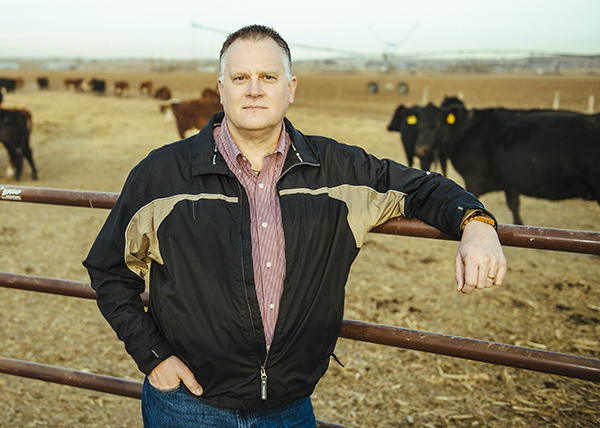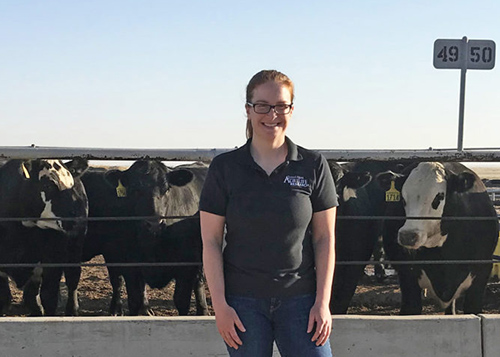VERO Places Texas A&M, WTAMU Faculty in Center Of Livestock Industry To Produce Impact-Driven Research
Story by Dorian Martin
A significant portion of the nation’s food animal industry will receive cutting-edge research support that will help producers grow and prosper in a time of increasing global demand and pressing sustainability issues thanks to an innovative partnership between Texas A&M University’s College of Veterinary Medicine & Biomedical Sciences (CVM) and West Texas A&M University (WTAMU).
While this collaboration, known as Veterinary Education, Research, & Outreach (VERO) program, offers a systematic approach that focuses on education and outreach, VERO has also been increasingly placing CVM and WTAMU researchers at the front and center of the nation’s food livestock industry.
VERO’s roots were planted in 2009, thanks to the combined vision of Dr. Eleanor Green, the Carl B. King Dean of Veterinary Medicine at Texas A&M, and Dr. Dean Hawkins, then-dean of WTAM’s Paul Engler College of Agriculture & Natural Sciences.
Initially, VERO’s focus was on creating educational and outreach efforts, such as the Food Animal Production & Rural Practice Tour and creating summer internships for CVM students; however, the addition of Dr. Paul Morley, VERO’s director of research, to the VERO team in early 2019 has ramped up the program’s research component.

Formerly a faculty member at Colorado State University’s College of Veterinary Medicine & Biomedical Sciences, Morley, an epidemiologist, based his decision to join VERO on the unprecedented partnership, which enjoys the support of the State of Texas, the Texas A&M University System, Texas A&M University, and WTAMU.
Under Morley’s direction, VERO’s research agenda will be driven by the industry’s needs.
For example, VERO researchers are currently conducting multiple U.S. Department of Agriculture-sponsored studies focused on respiratory disease in beef cattle, which is one of the most important problems to the beef industry.
“The goals of these projects include improving the detection and genetic characterization of respiratory pathogens, using state-of-the-art genomics tools to investigate evolution and spread in cattle populations, investigating the impacts of antimicrobial drug use on selection of resistant bacteria, improving early detection of sick cattle, and improving treatment strategies for the promotion of animal wellbeing,” Morley said.
The initiative’s scientists also are making groundbreaking discoveries related to antimicrobial use in animals and the impacts on antimicrobial resistance.
“Our research group has pioneered the use of next-generation sequencing to characterize the ecology of antimicrobial resistance in entire ecosystems of bacteria that live in and on animals,” Morley said. “We are using these tools to gain new understanding of how we can best promote the efficient production of food animals, while also promoting animal wellbeing, public health, and environmental sustainability.
“Our studies have provided an unprecedented ability to investigate specific uses of antimicrobial drugs to evaluate risks for promoting antimicrobial resistance,” he said. “Examples of this work include studies of bacterial communities in meat products and studies of whether people eating meat produced in conventional rearing systems that allow antimicrobial drug use are more likely to harbor resistant bacteria in their gut, compared to people who eat meat from animals raised without antimicrobial drug exposures.”
VERO’s research team also is focusing on learning more about infectious diseases in food animals through the use of state-of-the-art sequencing techniques.
“For example, liver abscesses are a very significant problem in beef and dairy cattle, and our previous understanding was developed through use of standard bacterial culture techniques that are largely unchanged from 100 years ago,” Morley said. “However, use of genetic sequencing has shown that the microbial communities in these abscesses are hugely complex, which suggests that we need to revise our approaches to prevention.”
Morley said that VERO’s research initiative, which already includes strong researchers who are part of WTAMU’s faculty, will only grow.
“Currently, we have four CVM faculty who have full-time assignments in Canyon specifically for the VERO program, but we partner and augment with additional faculty who are part of WTAMU’s Department of Agriculture Sciences,” he said. “We also are hiring a number of new faculty to bring in new research scientists who will help us grow what we’re currently doing in research.”
Ultimately, this research will play a part in tackling the global grand challenge of feeding a growing population, while also addressing resource issues related to land, water, and energy.

With the world population projected to be 10 billion people by 2050, producers will be required to double food production over current levels to avoid shortages and starvation. To do so, producers will need to become more productive and efficient, while also improving safety, sustainability, and ecosystem health.
“The kinds of things that Dr. Morley and his team of researchers tease out in Tulia, Plainview, Randle County, and Happy will have application to the cattle in Iowa, Colorado, Russia, and South Africa,” said Dr. Dee Griffin, VERO program director. “He literally has the opportunity in this unique laboratory to change the impact on the environment around the world and the interface between humans and animals.”
VERO, housed at WTAMU, uniquely positions Morley and his team for this line of research. At the ground level, the partnership is built on mutual respect and a focus on serving the Panhandle community.
“One of the reasons that this initiative is so unique is that while many veterinary schools in the country were set up in strong agriculture areas—particularly those in universities with land-grant status such as Texas A&M—that is no longer the case,” Morley said. “When these veterinary schools were established 100-125 years ago, cattle and horses were everywhere. Now, while many of those schools maintain a strong tie to agriculture, they are not where the animals are.
“Part of our philosophy is that West Texas A&M’s administrators and faculty are true teammates and we share the ownership and responsibility with them,” he said. “VERO’s location in Canyon makes it a magical opportunity for collaboration between researchers from West Texas A&M and Texas A&M.”
WTAMU serves a region that is home to a significant percentage of the food livestock industry. For example, approximately 30 percent of the nation’s beef cattle are fed or finished in the region, with 2.5 million beef cattle in the area at any given time. In addition, the region is home to other types of food animal production, including dairy cattle and swine.
“With all of the animals that are around here, that’s a huge economic boon for the state. To have research faculty out here addressing important research problems is a win-win for everyone,” Morley said. “What we’re trying to promote in our research program is the strong tie to the industry in terms of hearing their important needs—what problems they need us to work on and what areas that we can help them to financially successful and sustainable in terms of the consumer and the environment.
###
For more information about the Texas A&M College of Veterinary Medicine & Biomedical Sciences, please visit our website at vetmed.tamu.edu or join us on Facebook, Instagram, and Twitter.
Contact Information: Jennifer Gauntt, Interim Director of CVM Communications, Texas A&M College of Veterinary Medicine & Biomedical Science; jgauntt@cvm.tamu.edu; 979-862-4216


